Electrical Connections:
Complete the wiring of the new electrical outlet.
The electrical connections on the outlet are quite straightforward. The black, live wire, goes to one of the darker brass screws (it doesn't matter which one). The white, neutral wire, goes to one of the lighter brass screws (it doesn't matter which one) and the bare copper ground wire goes to the screw that is painted green and connected to the frame of the receptacle.
If you are using a metal electrical box, the bare copper ground wire should be run under the ground screw in the electrical box before it goes to the receptacle terminal. This why you need 9 inches of wire.
Mount the outlet (receptacle) in the electrical box and install the cover plate.
The next step is to connect the wires to their live or active counterparts. Turn off the power to the circuit that you are tapping into. Remove the cover plate or light fixture and if it is a receptacle or switch, remove the screws and pull the electrical device forward.
An electrical box is used as a junction box to join wires together to run to numerous devices throughout your home. It is impossible to cover all the wiring possibilities that can occur in any specific electrical box. In many cases it will be quite simplistic to identify the live cable and in others it will be quite a challenge.

Figure 1 - Electrical multimeter

Figure 2 - Voltage test lamp
An electrical multimeter, (Figure 1), or electrical voltage test lamp, (Figure 2), (there are hundreds of different makes and models of both) can help in more complex electrical situations.
When using any testing instrument, the power must be on. Always take appropriate caution when using any electrical testing device.
Connecting To A Receptacle:
If you are connecting to a previously installed electrical outlet (receptacle), you should only face two possible situations:
Additional information on terminating electrical wires.
- The electrical outlet (receptacle) is at the end of the line, in which case it is only necessary to connect the new cable wires to the appropriate terminals on that receptacle to extend the circuit to the new receptacle. The new ground wire should be joined to the old ground wire using a wire nut and pigtail. DO NOT place both wires under the receptacles ground terminal screw, see Figure 3.
- The receptacle is in the middle of a circuit and hence the terminals on the receptacle already have wires on them.
- With the power to the receptacle turned off, remove one of the black wires and one of the white wires (it doesn't matter which ones).

Figure 3 - wires joined together with wire nut
- Join the new black wire, from the new receptacle, to the existing black wire that you have removed - adding a pigtail wire to the junction, as shown in Figure 3. The other end of the pigtail is connected to the terminal where you removed the black wire.
- Follow the same procedure for the white wires.
- The two ground wires that are currently in the electrical box will either be twisted together or be connected using a wire nut. Join the new ground wire to that grouping. It is generally accepted that you should use wire nuts on ground wire connections. If the wires are only twisted together it is prudent to add a wire nut to the joint.
- Replace the old receptacle in its electrical box and re-install the cover plate.
DO NOT connect two black wires to one of the terminal screws on the receptacle.
